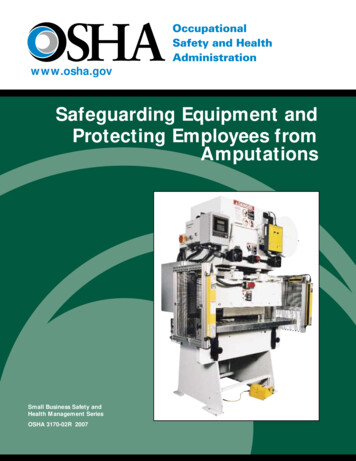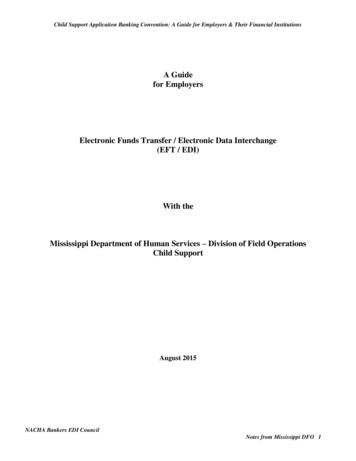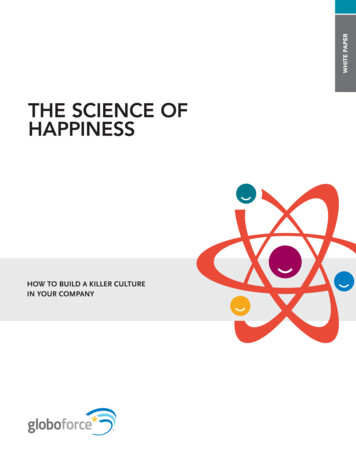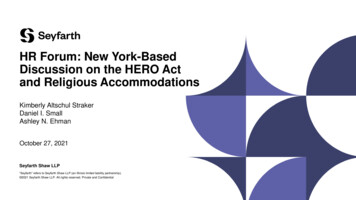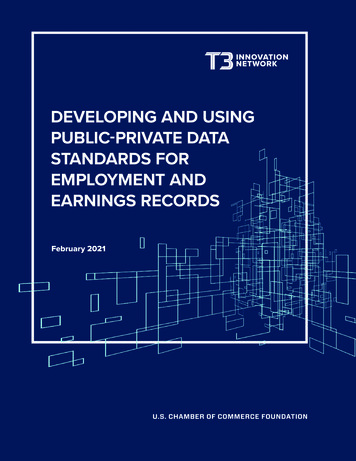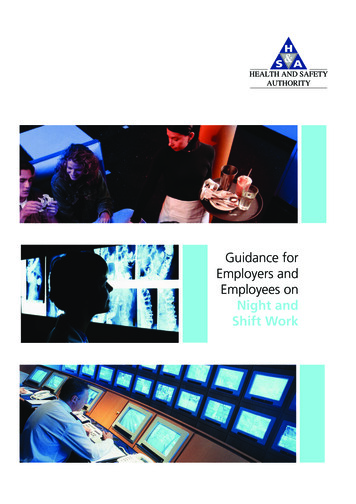
Transcription
Guidance forEmployers andEmployees onNight andShift Work
Our vision:A national culture whereall commit to safe andhealthy workplaces andthe safe and sustainablemanagement of chemicalsPublished in September 2012 by the Health and Safety Authority, The Metropolitan Building, James Joyce Street, Dublin 1. All rights reserved. No part of this publication may be reproduced, storedin a retrieval system, or transmitted in any form or by any means, electronic,mechanical, photocopying, recording or otherwise, without the priorpermission of the Health and Safety Authority.
ContentsAcknowledgement6.3Organisation of WorkingTime (General Exemptions)1.Introduction . . . . . . . . . . . .2Regulations 1998 . . . . . . .286.4Safety, Health and2.Background Information . .23.Effects of Night and Shift2007, Chapter 3 of Part 6:Work . . . . . . . . . . . . . . . . . .4Night Work and Shift3.1Introduction . . . . . . . . . . . .4Work . . . . . . . . . . . . . . . . .293.2Disruption of the internalWelfare at Work (GeneralApplication) Regulations6.5Regulation 151 of thebody clock (circadianSafety, Health and Welfarerhythms) . . . . . . . . . . . . . . .4at Work (General3.3Sleeping difficulties . . . . . .5Application) Regulations3.4Fatigue . . . . . . . . . . . . . . . .62007, Chapter 2 of Part 6:3.5Health effects . . . . . . . . . . .6Protection of Pregnant,3.6Individual factors . . . . . . . .7Post Natal and Breastfeeding3.7Social and family factors . .7Employees . . . . . . . . . . . .333.8Errors and accidents . . . . . .84.Risk Assessment . . . . . . . . .9Welfare at Work (General4.1Introduction . . . . . . . . . . . .9Application) Regulations4.2Establish a system to2007, Chapter 1 of Part 6:manage the risks . . . . . . . .9Protection of Children andAssess the risks in yourYoung Persons . . . . . . . . .346.6Regulations 143 and 146of the Safety, Health and4.3workplace . . . . . . . . . . . . .104.4Take action to reduce the7.risks . . . . . . . . . . . . . . . . . .104.5Review arrangementsShift Work Assessment Toolsand Techniques . . . . . . . .357.1regularly . . . . . . . . . . . . . .21List of shift workassessment tools andtechniques . . . . . . . . . . . .355.Practical Advice forEmployees . . . . . . . . . . . .235.1Introduction . . . . . . . . . . .235.2Driving to and from work . .235.3Sleep pattern . . . . . . . . . .235.4Sleep environment . . . . . .235.5Promoting sleep . . . . . . . .245.6Diet . . . . . . . . . . . . . . . . . .245.7Stimulants and sedatives . . .255.8Physical activity . . . . . . . .255.9Social support . . . . . . . . . .258.8.18.28.38.4Procedure for Night WorkerHealth Assessment . . . . .36Introduction . . . . . . . . . . .36Occupational Healthnight worker healthquestionnaire . . . . . . . . . .37Occupational Health nightworker health assessmentquestionnaire . . . . . . . . . .38Occupational Healthnight worker healthassessment questionnairereview form . . . . . . . . . . .405.10 Keeping alert at work . . .266.Legal Requirements . . . . .276.1Legislation . . . . . . . . . . . .276.2Organisation of WorkingTime Act 1997 . . . . . . . . . .279.9.110.Case Study . . . . . . . . . . . .41Case A . . . . . . . . . . . . . . . .41Publications and Sourcesof Information . . . . . . . . .4410.1 Publications . . . . . . . . . . .4410.2 Sources of information . .44
Guidance for Employers and Employees on Night and Shift WorkThe Health and Safety Authority (HSA) wishes to acknowledge the Health andSafety Executive’s UK publication, Managing shift work as a reference documentin parts of this guidance.1. IntroductionThe objective of this guide is to assist employers and employees and others to complywith health and safety legislation and in so doing to minimise any adverse effects ofnight and shift work. It is not intended as a legal interpretation of the legislation.This guide will increase your understanding of night and shift work and itspotential impact on health and safety. It will describe measures employers andemployees can take at work to reduce any adverse effects of night or shift work.It will assist employers in managing night and shift work so as to comply withthe legislation and to prevent fatigue and any associated illness arising in employees.The guide gives practical advice on carrying out risk assessments, shift design and themaintenance of the work environment.It also gives employees who carry out shift and night work advice on whatthey can do in relation to sleep and rest, health promotion, lifestyle, socialisation andfamily life in order to ensure a healthy and productive life.This guide should be read in conjunction with other legislation such as theOrganisation of Working Time Act 1997, and associated guides.2. Background InformationToday an increasing number of workers do shift and night work as part of their workcontract. There are a number of reasons for this and they include economies ofcontinuous production, business needs, the need to provide a 24 hour commercial oremergency service, work life balance, and globalisation.Shift and night work are common in sectors such as: 24/7 emergency services (e.g. ambulance, fire, hospital, police, prisons) 24/7 security services 24/7 utility services (e.g. electricity, gas, water) 24/7 production (e.g. chemicals, pharmaceuticals, manufacturing) Leisure and entertainment activities (e.g. bars, hotels, concerts, discos) Night work to ensure early next day service delivery (e.g. post, couriers, transport) Night work to ensure early next day product delivery (e.g. bakery, newspapers) Work across different international time zones (e.g. call centres, finance) Changing retail customer preferences (e.g. 24/7 supermarkets, garages)2The Health & Safety Authority
It is estimated that in Ireland approximately 15% or 270,000 of the working populationof 1.8 million workers do shift and night work on a regular basis and it is likely that thistrend will increase over the coming years.From the results of established evidence and reputable research it has becomewell known that shift and night work can lead to fatigue and other ill health effects andthese are described in Section 3. The main cause is the disruptions of “circadianrhythm”, which leads to fatigue. Our circadian rhythm basically keeps the body in tunewith daylight and night time hours. We have a natural inclination to be active duringdaylight hours and to rest and sleep at night when it is dark. The body clock is resistantto changes in this natural order of things. This is a reason why many find it hard tosleep during daylight hours after a night shift.There are many different types of shift work, with variations in shift duration,number of shifts, shift rotation, rest periods between shifts and days off. The design ofa particular shift pattern is a science in itself and will depend on many factors includingbusiness needs and the type of work being undertaken. As with other workplacehazards, the most important thing is to carry out a risk assessment and implementcontrol measures to minimise any possible adverse effects arising from the particularshift pattern and work. Risk assessment and measures to minimise risk factors aredescribed in the tables in Section 4 of this guidance. Shift workers themselves have abig role to play in promoting and maintaining their own health and Section 5 givespractical advice that will help them remain healthy.Council Directive 93/104/EC sought to minimise the adverse effects of bothexcessive hours of work and also night and shift work in the EU. Member Statesimplemented the provisions of this Directive in different ways. In England, the WorkingTime Regulations 1998 cover all these provisions. In contrast, in Ireland the Organisationof Working Time Act, 1997 stipulates maximum hours of work, minimum breaks anddays off while the original Safety, Health and Welfare at Work (Night Work and ShiftWork) Regulations 2000 were transposed into the Safety, Health and Welfare at Work(General Application) Regulations 2007 and deal specifically with night and shift work.These and other relevant legal provisions are outlined in Section 6 of this guidance.There is a requirement in the Night Work and Shift Work Regulations for employers tocarry out a night worker health assessment and an example of one is outlined inSection 8.There are a number of well established shift work assessment tools which canassist in identifying whether your existing shift schedule is likely to be causing fatiguein your workplace (see Section 7) and an actual case study is described in Section 9.Finally useful associated publications and sources of information are included inSection 10.The Health & Safety Authority3
Guidance for Employers and Employees on Night and Shift Work3. Effects of Night and Shift Work3.1 IntroductionThere is a considerable body of research evidence regarding the negative effects ofnight and shift work. These effects include: Disruption of the internal body clock (circadian rhythms) Sleeping difficulties Fatigue Health effects Individual factors Social and family factors Errors and accidentsThese effects obviously do not happen to all night and shift workers and with propermanagement the risks can be minimised. Fatigue is the main issue which needs to beaddressed.3.2 Disruption of the internal body clock (circadian rhythms)3.2.1 Biological clocksA master clock in the brain coordinates the various body biological clocks so that theyare in synch. The biological clocks in turn drive our circadian rhythms. The master clockconsists of a group of nerve endings called the suprachiasmatic nucleus (SCN), whichis located in the hypothalamus area of the brain close to the optic nerves.3.2.2 Circadian rhythmsCircadian rhythms are physical, mental and behavioural changes that follow roughly awhole day or twenty four hour cycle. Circadian rhythms are produced by natural factorsin the body such as genetic activity and the release of the hormone melatonin, butthey are also affected by signals from the environment, especially light. Light is themain cue influencing circadian rhythms, turning on and off genes that control theinternal clocks. Circadian rhythms can change sleep-wake cycles, hormone release,body temperature and other important bodily functions.Circadian rhythms are important in determining human sleep patterns. Thebody’s master clock or SCN controls the production of melatonin that makes us sleepy.As it is located just above the optic nerves, which relay information from the eyes(external environment) to the brain, the SCN receives information about incoming light.When, there is less light, such as at night or in darkness, the SCN directs the brain toproduce more melatonin, so you get drowsy or sleepy.Melatonin, which is vital to the suppression of tumours, is released at night.4The Health & Safety Authority
Light shuts down melatonin production, so being exposed to artificial light at nightcould lead to a melatonin deficiency.Disruption of the circadian rhythm is linked to various sleep disorders such asinsomnia, disrupted sleep-wake cycles and insufficient hours of sleep. Disruptedcircadian rhythms are also associated with depression, bipolar disorder and seasonalaffective disorder.Night and shift work can cause disruption to the circadian rhythms. Basicallyif you are working at night, you are not sleeping when your body tells you should be.Conversely when you try to go to sleep during the day it is not easy as the circadianrhythm is telling you that you should be awake and this is supported by cues such asdaylight and normal daytime external environmental activities such as traffic and noise,which make it more difficult to sleep.Our internal body clocks can change gradually but are resistant to abruptchanges brought on by night and shift work. Nor will they ever fully adjust, even forthose workers on permanent night shifts. Such workers may sleep during the day whenthey are on their rest period between shifts but on days off their body clocks willattempt to reset to normal circadian rhythms.The end result of disruption of the circadian rhythms is loss of sleep anddisturbed sleep, which both lead to fatigue.3.3 Sleeping difficultiesWe all need proper sleep in order to wake up refreshed and energised for the day’sactivities. Sleeping is restorative both physically and mentally. It allows the body torecover from the days exertions, be they physical or cognitive activities. People whohave problems sleeping can become anxious and worried when they lie awake. Theymay get some broken periods of sleep but when they get up they are still tired andlack energy. Insufficient sleep is associated with tiredness leading to accidents and errorsas the body and mind are out of tune with their environment.Because of our circadian rhythms and external cues such as sunlight,temperature, voices, traffic, family and domestic responsibilities, it is much more difficultto get a proper sleep of sufficient duration without interruptions during daylight hours.This lack of sleep leads to “sleep debt” whereby the body knows it has hadinsufficient sleep and although we can cope with this temporarily, eventually whenworking at night, we will feel a deep need of sleep and may fall asleep on the jobdespite other external cues. Recent cases from April 2011 where air traffic controllersin the US fell asleep at night when they were on duty highlight the issue and theassociated danger.The Health & Safety Authority5
Guidance for Employers and Employees on Night and Shift WorkSleep deprivation affects our ability to think and concentrate and can lead tocognitive errors in tasks requiring concentration, fast reaction times, good memoryfunction, vigilance, awareness and decision making.3.4 FatigueFatigue is the decline in mental and/or physical performance that results from prolongedexertion, lack of quality sleep or disruption to the circadian rhythms. It is a feeling oftiredness and being unable to work effectively. A fatigued person will be less alert andperceptive, less able to process information and have slower reaction times thansomeone who is not fatigued. A person who is fatigued may fall asleep momentarilywhile at work or driving home, which can be extremely dangerous.Fatigue results from an imbalance between work demands and rest andrecovery periods. Poorly designed shift work patterns and long working hours are likelyto result in fatigue. Fatigue is the most common adverse effect of shift and night work.Fatigue can also lead to errors and accidents (see 3.8) while chronic fatigue isassociated with a number of adverse health effects and illnesses outlined below.3.5 Health effectsThere are a number of well documented illnesses associated with night and shiftworkers, while other emerging risks are presently undergoing evaluation and research.Night and shift work are also known to exacerbate a number of pre- existing illnesses.The majority of illnesses are due to disruption of the circadian rhythms resulting inhormone imbalance (melatonin suppression), sleeping difficulties and fatigue.Chronic fatigue resulting from night and shift work is strongly associated withgastrointestinal illnesses such as abdominal pain, chronic gastritis, peptic ulcers andcardiovascular illnesses such as hypertension and coronary heart disease. A recent studyin 2011 by researchers from University College London found that working more than11 hours places a person at a 67% higher risk of developing heart disease comparedwith those who work a typical 7 or 8 hours a day (Mika Kivimaki et al, “Using AdditionalInformation on Working Hours to Predict Coronary Heart Disease: A Cohort Study”,Annals of Internal Medicine, April 2011 154(7), 457–463).There is strong evidence for reproductive problems in female shift workers,especially those carrying out night work. This is why under the Pregnancy at WorkRegulations 2007, pregnant night workers can be moved to day work if it is the opinionof a doctor that the night work is having a detrimental effect on their health or thedeveloping child.6The Health & Safety Authority
Recent research in the US and Denmark found increased rates of prostatecancer in men and breast cancer in women who regularly carried out night work overa period of years. As a result the International Agency for Research on Cancer (IARC)of the World Health Organisation (WHO) classified night work as a probable carcinogenin 2009.Subsequently, the Danish government paid out compensation to a number of femaleworkers, mainly nurses and air flight attendants, who developed breast cancer and hadcarried out night work over many years. A recent report in 2010 by the HSEUK entitledThe burden of occupational cancer in Great Britain attributes the largest number ofoccupational breast cancer deaths and registrations in women to shift work.Shift work is also known to exacerbate pre-existing illnesses for night and shiftworkers. These include asthma, diabetes, epilepsy and psychiatric illness. This is whynight workers have been given an entitlement to a health assessment under the NightWork and Shift Work Regulations to assess their suitability for such work beforecommencing work and then at regular intervals thereafter.3.6 Individual factorsIndividuals react differently to the effects of night and shift work. Workers who do thesame shifts and same tasks can experience different health effects. Some will remainperfectly healthy while others may develop health problems. This reflects a combinationof factors including: age, gender, lifestyle, attitude and behaviour.Individuals’ tolerance of shift work varies according to their: Ability to sleep (some people are good sleepers regardless while others find it difficultto fall asleep and even when they do, they wake up a number of times) Ability to adapt to changes in shift pattern Ability to adapt to shift work (which decreases with age anyway) Different life style behaviours (e.g. alcohol consumption, diet, levels of fitness) Different coping mechanisms3.7 Social and family factorsSocial and family factors can have a big impact on a shift worker’s mental and physicalhealth. Workers who don’t have sufficient time to interact with their families and friendsbecause of shift working and the need to rest in between may feel deprived andisolated, leading to moodiness and negativity. This can affect their relationships both athome and at work.The Health & Safety Authority7
Guidance for Employers and Employees on Night and Shift WorkOn the other hand, some workers will try to maintain a normal family andsocial life, but as a result not sleep sufficiently and end up fatigued. Thus there is a finebalance to be struck between these competing demands. The design of shift patternscan have a major impact in this area (e.g. 8 hour versus 12 hour, 2 daytime shifts notinvolving a night shift, no shift working at weekends, etc (see Section 4)).3.8 Errors and accidentsThe risk of errors and accidents has been found to: Be higher on night shifts Rise with increasing shift length over an 8 hour threshold Increase over successive shifts (especially night shifts) Increase when there are insufficient breaksThe main cause is poorly designed shift schedules resulting in fatigue, which in turnleads to poor performance resulting in errors and accidents. These can be a mixture ofminor and major incidents. Fatigue is a major contributory factor in road trafficaccidents. Who has not experienced the feeling of nodding off while driving but luckilyregaining alertness just in time?Fatigue, night work and shift work arrangements have been found to becontributory factors to such well known incidents as Three Mile Island (nuclear powerstation release) in 1979, Bhopal (chemical plant explosion) in 1984, Challenger SpaceShuttle (rocket explosion) in 1986, Chernobyl (nuclear power station release) in 1986,Clapham Junction (rail crash) in 1988, Exxon Valdex (ship oil spill) in 1989 and theBuncefield (oil refinery explosion) in 2005.8The Health & Safety Authority
4. Risk Assessment4.1 IntroductionRisk assessment in this context is the process of identifying the hazards associated withnight and shift work in your workplace, assessing those risks, implementing measuresto reduce and control them and reviewing the effectiveness of these arrangements.In Section 3 the negative effects of night and shift work were outlined. Bycareful management of shift work, these effects can be minimised and workers canremain healthy and accidents and errors prevented. What is required is a commitmentfrom management to address the risks and maintain workers safety, health and wellbeing. This should not just be seen as complying with a legal requirement but also assound business practice as costs will be minimised by: Reduced sickness and absence Reduced staff turnover Reduced number of errors and accidents and their associated costs Having more healthy and productive workersA four stage risk assessment process should be implemented:1.Establish a system to manage the risks.2.Assess the risks in your workplace.3.Take action to reduce the risks.4.Review arrangements regularly.The employer or manager should be able to carry out the risk assessment without theneed for external consultants as he or she should know the work processes better thananybody. These stages will be described in more detail below.4.2 Establish a system to manage the risksIn order to address the risks arising from shift work, a systematic approach is advisedcomprising : Management commitment and resources Appointing a competent person to carry out the risk assessment Consultation and involvement of workersManagement need to make a commitment to carrying out risk assessments, addressingany issues identified, implementing any recommendations and providing any resourcesrequired (both personnel and finance). In larger organisations it may be practical toappoint a competent person who has knowledge of the legislation, the effects of shiftwork and the design of shift work schedules to carry out the risk assessment. In mostcases the competent person should be a manager of the company and there should beno need for an external consultant.The Health & Safety Authority9
Guidance for Employers and Employees on Night and Shift WorkIt is vital that shift workers are consulted and involved in any decisions aboutshift work. Not only is this a legal requirement but also shift workers have theexperience and knowledge which is vital to the overcoming of the actual effects of theshift work that they are doing on a regular basis and they will have opinions on theduration of shifts, their rotation, breaks and rest periods, work tasks, environment andwelfare facilities.Existing consultation arrangements may already be adequate but, if shift workis being introduced for the first time or major changes to existing shift schedules areplanned, it may be prudent to set up a working committee comprising managementand worker representatives and occupational health experts, if available. It should bekept in mind that workers often begin by resisting any proposed changes in their shiftschedules even if there are likely benefits for the majority as they are comfortable withthe way things are being done.4.3 Assess the risks in your workplaceA risk assessment should take account of fatigue and the likelihood of it occurring asa result of shift work. It need relate only to night and shift work and need not takeaccount of other workplace hazards, which should be addressed separately. Forexample, if there is a lot of manual handling which could cause fatigue, that should beincluded, but hazards relating to machinery should not.The risk assessment will require the collection of information of both atechnical and non-technical nature with the objective of determining if shift work islikely to cause fatigue in shift workers.There are a number of well known risk factors for shift workers such asworkload, work activity, shift pattern, rotation, timing and duration, rest breaks withinand between shifts, physical environment, management issues and welfare, which willbe described in much more detail in the tables in Section 4.4.1 below. These risk factorsneed to be considered as part of the risk assessment.In addition you need to consider sensitive risk groups such as pregnantworkers, younger and older workers, workers with pre-existing health conditions andnew and temporary workers, who may be more at risk than other shift workers.In order to identify trends associated with shift work, not only will you needto consider the risk factors and categories of employees outlined above, but you willalso need to gather and use data from a variety of sources, including healthassessments, sickness certificates, absence records and information on accidents, nearmisses, productivity, production and service quality.4.4 Take action to reduce the risksThe tables in Section 4.4.1 describe risk factors associated with shift work and give10The Health & Safety Authority
practical advice on how to control them. They also indicate specific legal requirements where they are applicable. Thetables are summarised in Section 4.4.2 into two good practice guidelines, one on the design of the shift workschedule and the other on the shift work environment.The tables will help you identify particular risk factors in your workplace. In some instances they give anevaluation of the relative risks of one factor over another (e.g. rotating shifts versus other shift patterns in Table 3).In others, such as Table 9, they illustrate how the failure to manage specific issues can increase the risks involved innight or shift work. Once you have identified the various risk factors, you need to make improvements to eliminateor reduce these risks. As previously stated, it is vital to consult shift workers in the risk assessment process and beforeimplementing any improvements.4.4.1 Risk factorsTable 1: WorkloadWorkloadCommentsAdviceMental and physicalWorkers with an appropriate workload will bePlan an appropriate workloaddemandsmore effective and productive and less fatiguedthat accords with the lengththan those with too much or too little to do.and timing of the shift.Concentration and productivity tend to declineIf practical, schedule demand-towards the end of the shift, or following lunch oring work for periods whenduring the night and early hours of the morning.workers are most alert andleast likely to be fatigued.Where possible, demanding,dangerous and safety criticalwork should be avoided atnight time, in the early hours ofthe morning or at the end oflong shifts.Where work is particularlydemanding, consider shorteningthe length of the shift.Table 2: Work activityWork activityCommentsAdviceWork activityVariation in work activity across a shift can helpWhere possible, schedule arelieve fatigue, especially where a worker has avariety of tasks into the shiftrange of tasks to complete, each with differentand if practicable, allowmental and physical demands.workers some choiceAlternating routine sedentary mental tasks withphysical tasks can promote alertness and helpregarding their order ofcompletion.relieve fatigue.The Health & Safety Authority11
Guidance for Employers and Employees on Night and Shift WorkTable 3: Shift pattern and shift rotationShift patternCommentsAdviceRegular shiftsRegular shifts allow a worker to adjust to a shiftschedule to a certain degree, although anyadjustment of the internal body clock will be lostduring rest days if they revert to a normal diurnalcycle.Permanent night shifts shouldbe avoided where possible.Permanent night workers and early morningworkers run the risk of chronic sleep debt, fatigue,ill health and disruption of family and social life.Rotating shiftsRegular shifts allow workers plan family and socialactivities. They appeal to some but others preferthe flexibility of rotating shifts.If practicable, offer workersthe choice betweenpermanent and rotating shifts.Regular shifts can create strong bonds within shiftteams but may also allow poor attitudes andbehaviour to develop leading to poor decisionmaking.Ensure there is adequatesupervision.Regular shifts may lead to poor communicationbetween different shift teams.Ensure adequate time at shifthandover so that new shiftteam is fully aware of anyissues in previous shift.Rotating shift schedules reduce the number ofnights a worker has to work as night work isshared among all workers.Plan the direction and speed ofrotating shifts to assist aworker adapting to rotatingshifts.However, the constantly changing shift patternmeans workers may have difficulty adapting to therotating schedule.Forward versusbackward rotationFast versus slowrotationEnsure permanent night andearly morning workers areaware of the risks throughprovision of information.There is some evidence that the internal body clockadapts more quickly to forward rotating schedules:i.e. where the worker progresses from morning toafternoon to night shifts.Adopt forward rotatingschedules where possible.Changing from an early to a later shift may resultin reduced rest time compared with a backwardrotating schedule.Ensure there is adequate resttime between shifts to complywith the 1997 Act: i.e. aminimum period of 11 hours.Fast rotation of shifts minimises disruption of theinternal body clock and there is little or noadaptation to night shifts and early morning starts.Rotate shifts every two tothree days where possible.Therefore direction of rotation may be less relevantfor fast rotating shifts,12The Health & Safety AuthorityWeekly/fortnightly rotating shifts are the mostdisruptive schedule as the internal body clock startsto adapt and then has to readjust as the shiftchanges.Avoid weekly/fortnightlyrotating shift schedules wherepossible.Slow rotation of shifts maximises adaptation of theinternal body clock. However, any adjustment tonights/early morning starts will be lost during restdays.If fast rotation
attempt to reset to normal circadian rhythms. The end result of disruption of the circadian rhythms is loss of sleep and disturbed sleep, which both lead to fatigue. 3.3 Sleeping difficulties We all need proper sleep in order to wake up refreshed and energised for the day’s activiti






